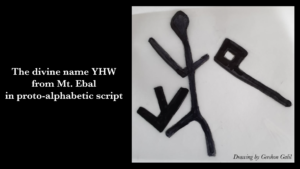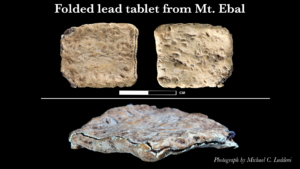Questions abound following announcement of sensational new find
Nathan Steinmeyer April 25, 2022 0 Comments 765 views
In early 2022, a research team led by scholars from the Associates for Biblical Research (ABR) announced the discovery of a lead tablet from Mt. Ebal that they claim contains the oldest extant Hebrew inscription. They say the inscription, which they date to the end of the Late Bronze Age (c. 1200 B.C.E.), is a legal text and curse that invokes the god Yahweh. The team believes the tablet to be the most important inscription ever found in Israel and one that could drastically alter our reconstruction of ancient Israel’s earliest history. Questions abound, however, and some scholars have expressed serious doubts about the team’s sensational claims, while other observers have pointed out the problematic circumstances surrounding its recovery.


The Mt. Ebal Inscription
Announced during a press conference in March 2022, the tablet comes from the West Bank site of Mt. Ebal, which was first excavated by archaeologist Adam Zertal in the 1980s. The site consists of two large stone installations, one circular and one rectangular. Zertal interpreted the site and the earlier circular feature to be the location of Joshua’s altar (Joshua 8:30), though many dispute this identification. The tablet was only recovered in 2019, however, when archaeologists with ABR began a project to sift the soil dumps from the Mt. Ebal excavation in hopes of identifying artifacts that had been missed during the original dig.
The lead tablet, which measures less than 1 inch square, appears to have been folded in half after being written. This makes it impossible to read without advanced digital scanning, which was carried out in Prague by the Academy of Sciences of the Czech Republic. Although images of the scans have not been released, the ABR team says that the inside contains 40 letters written in four lines of text. As translated by the team, the tablet reads:
“Cursed, cursed, cursed—cursed by the God Yhw. You will die cursed. Cursed you will surely die. Cursed by Yhw—cursed, cursed, cursed.”
The team claims the inscription is written in an archaic script, which they term “proto-alphabetic.” Furthermore, they suggest that the use of the name Yhw, a shortened version of the divine name Yahweh (YHWH), is clear evidence that the text is an archaic Hebrew inscription. If true, this would make the tablet hundreds of years older than previously known early Hebrew inscriptions. They also suggest that the inscription provides the earliest reference to the name Yahweh found in ancient Israel.


A schematic rendering of the name YHW in the Mt. Ebal inscription. Image by the Associates for Biblical Research.
Big Claims about a Small Tablet
According to the team, the tablet is a type of legal text, which threatens curses upon individuals who transgress a covenant. As such, they connect the find directly to the covenant renewal ceremony on Mt. Ebal, described in Deuteronomy 27 and Joshua 8. Moreover, the team claims the tablet is evidence that certain books of the Hebrew Bible could have been written down hundreds of years earlier than most biblical scholars previously thought. As stated by the ABR’s Director of Excavations, Scott Stripling, “One can no longer argue with a straight face that the biblical text was not written until the Persian period or the Hellenistic period, as many higher critics have done, when we clearly do have the ability to write the entire text [of the Bible] at a much, much earlier date.” The project’s epigraphers, Gershon Galil of the University of Haifa and Pieter van der Veen of Johannes Gutenberg-Universität Mainz, reiterated the point, with Galil saying, “The scribe that wrote this ancient text, believe me, he could write every chapter in the Bible.”
Scholars Remain Skeptical
Although the team’s claims about the lead tablet have made headlines in Israel, and been the subject of popular biblical archaeology podcasts and social media discussions, some scholars and other observers have questioned the find and remain skeptical about its contents and importance. The main reason is that, until now, the team has provided very little written or visual documentation to support their reading and interpretation of the tablet. At the March press conference, the team released a photo of the outside of the tablet (first image, above) and a schematic drawing of the three letters they read as the divine name Yhw (second image, above), but they did not release any images of the scans that show the tablet’s inscribed interior. Additionally, the team has yet to publish the find or their analysis in a peer-reviewed journal, although they are now preparing an article that they hope will appear later in 2022. This lack of any presentation of the supporting evidence for the team’s claims has raised the suspicions of many scholars. As Christopher Rollston, a noted epigrapher from the George Washington University, wrote on his blog, “I would predict that almost all of the readings posited in the press conference will be vigorously contested, once scholars in the field of epigraphy are allowed to see the image. … I am far from convinced of their readings … especially since they have not even provided so much as a single good image!”
Even if the ABR team’s reading holds up under scrutiny, however, Rollston and others caution against making too much of the tablet’s date and significance. Rollston points out, for example, that alphabetic writing was already fairly well known by the late second millennium, likely having been invented sometime around the 18th century B.C.E. Furthermore, even if the team’s reading is accurate, the 40 letters that make up the text were used to write just four unique words: “cursed,” “die,” “god,” and “yhw.” According to Rollston, “To say that based on those four words or roots that somebody could write the whole Bible … well, that’s a bridge (way) too far for me. After all, there are 8500+ words in the Hebrew Bible … and four is a pretty small fraction of the whole, therefore!” Other scholars, like archaeologist Aren Maeir of Bar-Ilan University, note that while the team’s reading of the Mt. Ebal inscription could provide the earliest reference to the divine name Yahweh in ancient Israel, it would not be earliest reference to Yahweh ever found, as possible earlier occurrences have been found in Egypt and elsewhere.
Problems of Provenance
There are also serious questions about where the tablet was found and how it was discovered. As noted above, the tablet was not found during an excavation but rather while the ABR team was sifting the soil dumps from Adam Zertal’s earlier excavations. As such, the find does not come from a datable, stratified context, though the ABR team says it was able to associate the dump material where the tablet was found with Zertal’s excavation of the altar, which he dated to the time of Joshua. This corresponds to the team’s dating of the script, as well as analysis of the tablet’s lead, which originated from a mine in Greece that was in use during the Late Bronze and early Iron Ages.
Perhaps even more significant is the fact that Mt. Ebal is located in Area B of the West Bank, just a mile north of the Palestinian city of Nablus, and, as such, its archaeology falls under the jurisdiction of the Palestinian Authority. An investigation by Haaretz found that the ABR team failed to get permission for the Mt. Ebal sifting project from either the Palestinian Authority or Israel’s Staff Officer for Archaeology of the Civil Administration of Judea and Samaria, calling into question the legality of the project and the find. Additionally, the ABR team did not receive an export license to take the tablet out of the country for analysis, as is required by Israeli law.
Ed. Note: Christopher Rollston is a member of the Editorial Advisory Board of Biblical Archaeology Review.
Read more in Bible History Daily:
A Biblical Altar on Mt. Ebal and Other Israelite Footprints in the Jordan Valley?
All-Access members, read more in the BAS Library:
Two Early Israelite Cult Sites Now Questioned
Has Joshua’s Altar Been Found on Mt. Ebal?
Not a BAS Library or All-Access Member yet? Join today.


